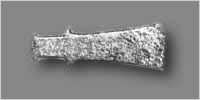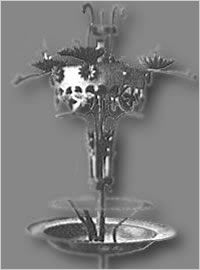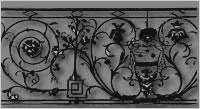 |
| Fig. 1. An iron axe of Galchtad cultures (approximately 900-400 up to AD) |
The history of forging leaves deep into millennia. Forging - a way of processing of the metals, described by that current of a material in the sides, as a rule, is not limited to a tool - stamp. With help of forging products in weight up to 200 ton are received. Forging was applied even before development of melt of iron from ore; forged goods from meteoric iron were made manually in 4-3 thousand up to AD. The First subjects from iron, be they of a meteoric or terrestrial origin, always appreciated very highly and stored in temples among the most expensive treasures or placed in tombs of powerful governors.
One of the most ancient iron object is, for example, the iron dagger of tsar of the Bag - Lamchar from ancient Ur, concerning to the middle of III millennium up to AD and has been found among gold goblets, ornaments, musical instruments and separate details of a gold amour. The products concerning to the beginning and the middle of a bronze age, find any more only in the remote areas, but also in layers of the ground of the Central Europe. In area Fourfold (northwest Germany), in a rich burial place the iron ring has been found; the iron plate from a tomb close Aveyron (France) is known, the iron pin has been found in a rich tomb in Shedding near to Stendhal on Elba (Germany). Recent excavation in Slovakia also has brought the important discovery, in particular handle of a dagger, found in Gannovets (Northern Slovakia).
 |
Fig. 2. A candelabrum from Catalonia. 15 century Museum Kau Ferrate. Barcelona. |
Forging is one of ways of processing of metals by pressure at which the tool renders repeated faltering influence on part blank, therefore it being deformed, gradually gets the set form and the sizes. From an antiquity forging (copper, native iron) served one of the basic ways of processing of metal (cold, and then and hot forging in Iran, Mesopotamia, Egypt in 4-3 thousand up to AD; cold forging at Indians Northern and South America till 16 century AD).
Ancient metallurgists of Europe, Asia and Africa forged raw iron, copper, silver and gold; smiths used special honor at peoples of an antiquity, and their art was surrounded by legends. In Middle Ages, including in Russia, forge business has reached a high level: manually cold steel and fire-arms, tools, details of agricultural instruments, doors and chests, lattices, fixtures, locks, hours, etc. products of every possible forms and the sizes, frequently with the most thin details were forged; forged products were decorated with a notch, punching or the relief pattern, the sheets of mosaic gold flattened out in the most thin layer and bronze shit. Traditions of medieval craft were kept in a folk art till 19 century (hooks, candlesticks, etc.). In 15-19 centuries many forged products were executed: remarkable forged lanterns, fencings, lattices, a gate (Versailles, Petersburg, and Tsarskoe Selo).
Many cities specialized in various branches of forge craft: Herat, Mosul were glorified by utensils, Damascus, Milan, Augsburg, Astrakhan, Tula - the weapon, Nottingham, Solingen, Pavlovo on Oka - knifes and tools, Nuremberg, Holm-goru - locks, etc. In 19 century manual art forging has been superseded by punching and moulding, interest to it has revived in 20 century (F.Kjuna's works in GDR, I.S.Efimova, V.P.Smirnova in the USSR; exteriors, interiors in Tallinn, Kaunas, etc.). Forging, as a rule, is made at heating metal up to forged temperatures with the purpose of increase of its plasticity and decrease its resistance to deformation.
The historical information. IRON (Latin - Ferrum) was known during prehistoric times, however wide application has found much later because of in a free state in the nature meets extremely seldom, and its reception from ores became possible only on the certain level of development of techniques.
 |
Fig. 3. A lattice of a fencing near the house Chellesy in Arezzo. 17 century |
Probably, for the first time the person has got acquainted with meteoric iron to what its names in languages of ancient peoples testify: Old Egyptian "be-ni-pet" means «heavenly iron»; ancient Greek the star, a heavenly body connects with Latin sidus in Hittite texts of 14 century up to AD. It is mentioned about iron as about the metal fallen from the sky. In Romance languages the root of the name given by Romans (for example was kept, French fer, Italian ferro). The way of reception of iron from ores has been invented in the western part of Asia in 2-nd millennium up to AD; after that application of iron was distributed in Babylon, Egypt, Greece; on change to a Bronze Age there has come the Iron Age. Homer (in 23-rd song of "Iliad") tells that Achilles has awarded with a disk from iron bloom the winner in competition on a throwing of a disk. In Europe and Ancient Russia within many centuries iron received from a raw process. Iron ore were restored by wood coal in the forge arranged in a hole; in a forge furs forced air, a product of restoration - bloom by impacts of large hammer separated from slag and from shaped it various products. |

